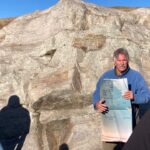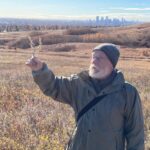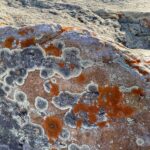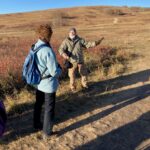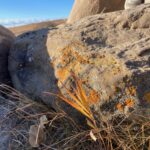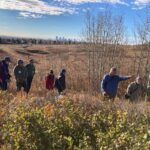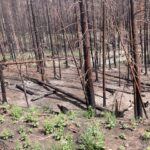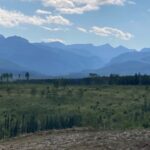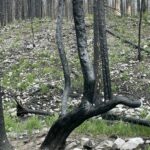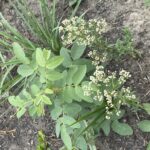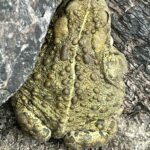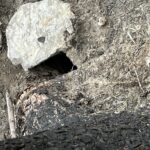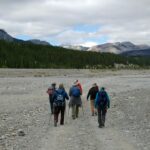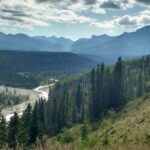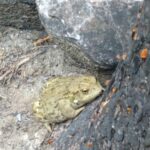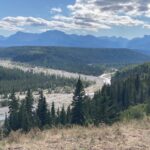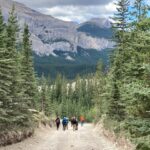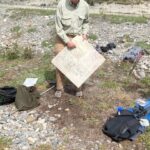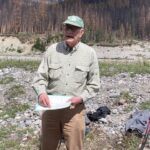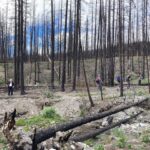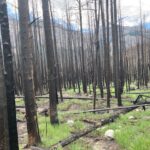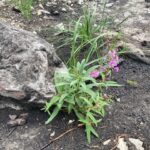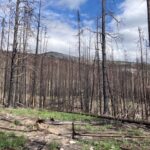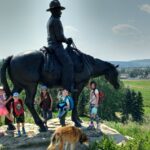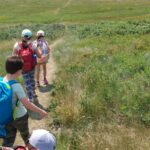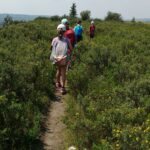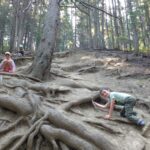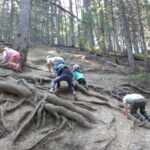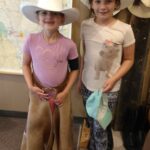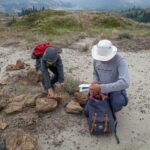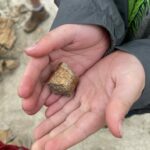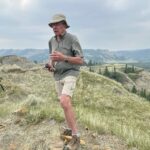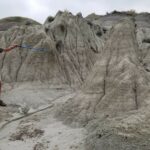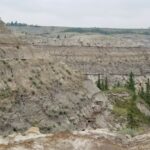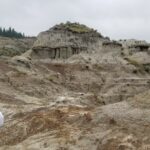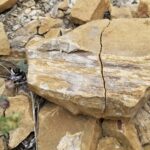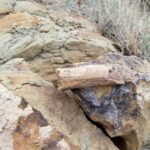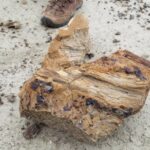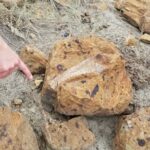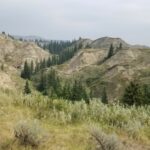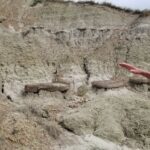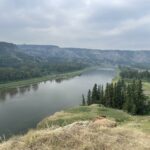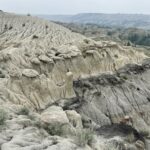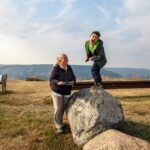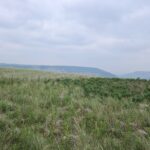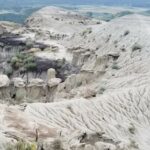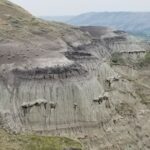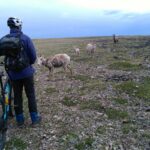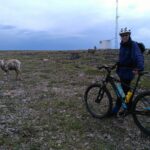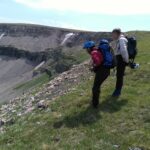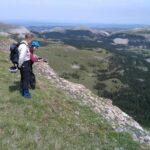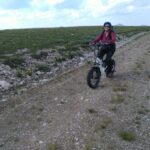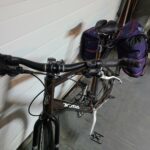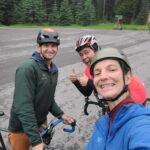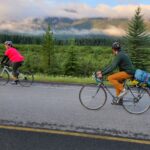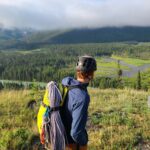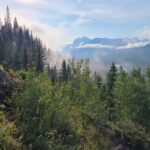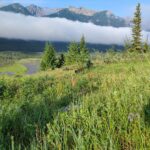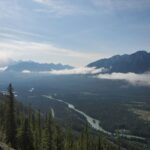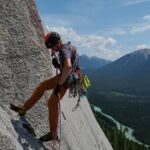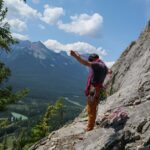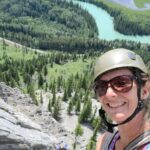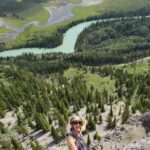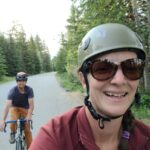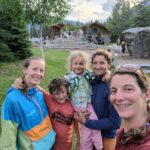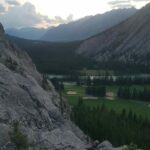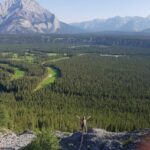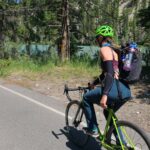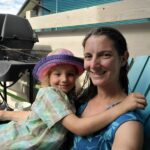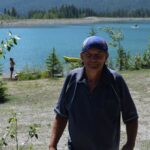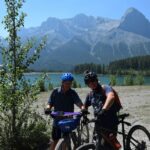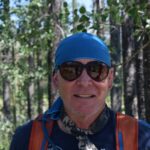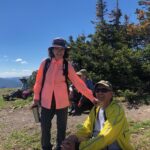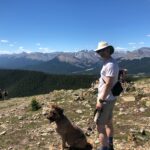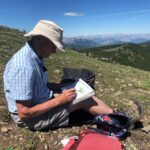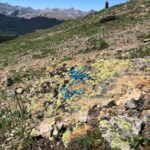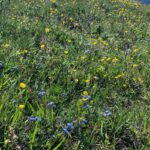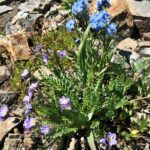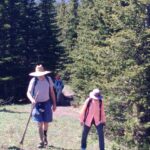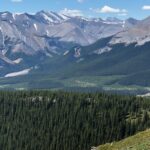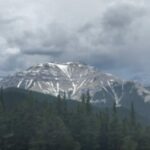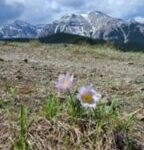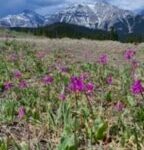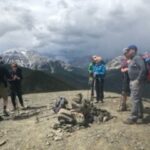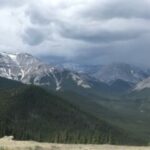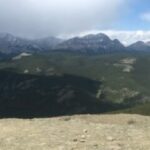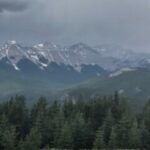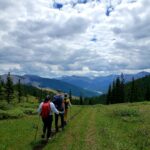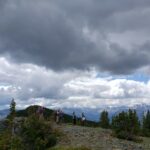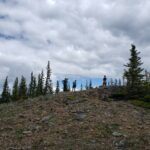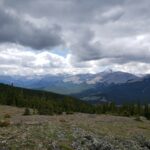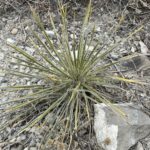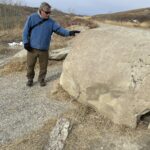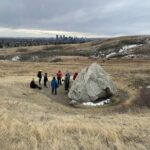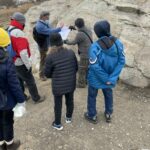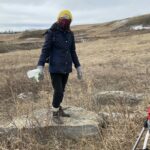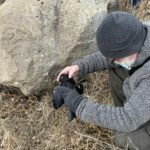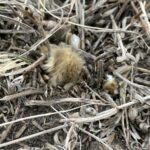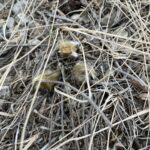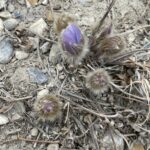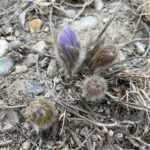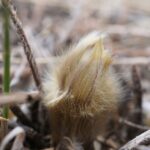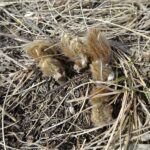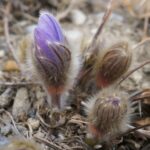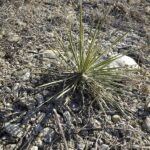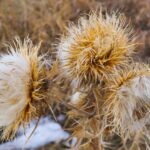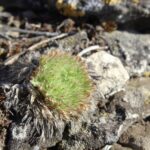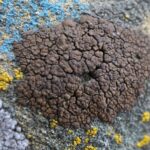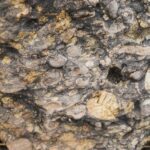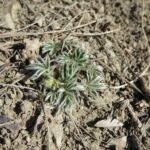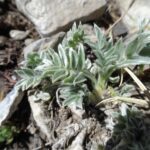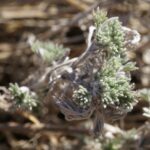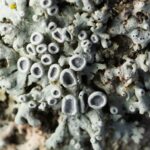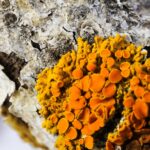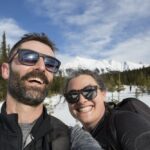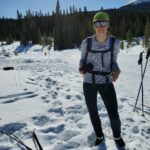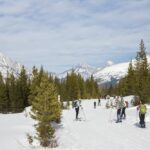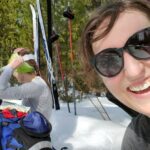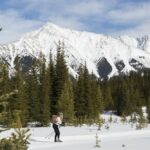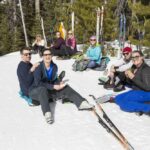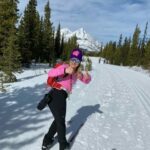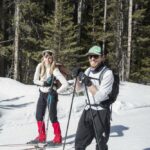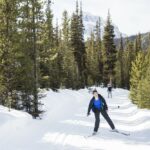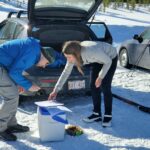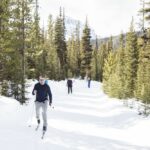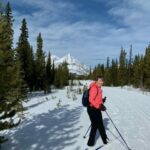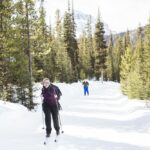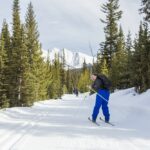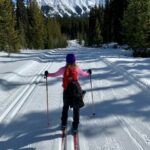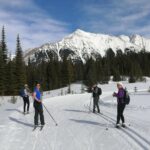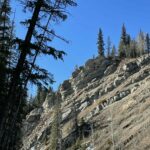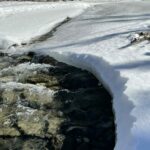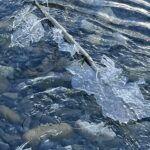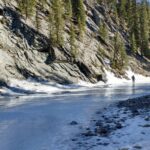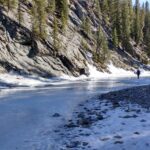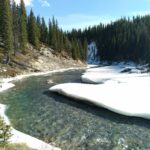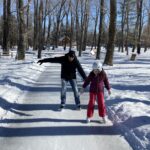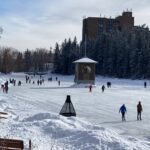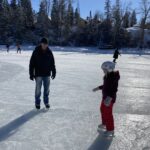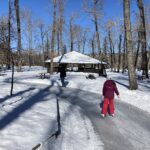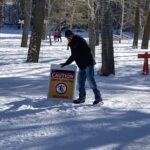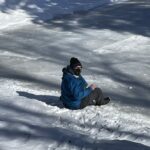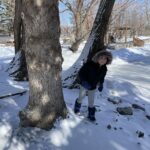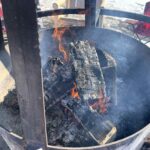2021 Photo Gallery
Check out all the fun everyone’s been having on our adventures!
As the adventures take place over the course of 2021, be sure to check back here for photos from the adventure, a report back, and more!
(Looking for stories and photos from 2020? Click here or see the “past adventures” menu above.)
Here’s what we have so far…
Fall Ramble on Nose Hill
with Christyann Olson, on 21 October, 2021
(story from Wendell Koning, AWA member and field trip participant)
On the morning of October 21st, about 15-20 of us gathered in the early morning sun, to learn more about the botany and geology of Nose Hill Park. The park is found in the northwest part of the city covering 11 sq km. From the top of the hill, on the plateau, one can get awesome views of the downtown to the south; the airport (airplanes coming and going) to the east; and the Rocky Mountains to the west. And in some parts of the park, namely in the many valleys, you can feel what it was like 200 years ago, to be all alone on a native prairie!
Christyann Olson, recently retired Executive Director of AWA, gave a brief overview about the AWA and the history of the park. We had two specialists for this tour, Karel Bergmann, a very experienced botanist, with a wealth of local and international knowledge, and senior geologist Tako Koning, who is passionate about all things geology.
The two specialists worked in tandem – Karel would show us various plant species and how they are adapted to their specific environments, and then we’d stop at rocky outcrops including some massive rocks known as glacial erratics, to learn more about glaciations, rock striations, and the various fossils that could be found (sorry, no dinosaur fossils at Nose Hill, but plenty of other types!).
And at the same rocks or nearby rocks, Karel, an expert on lichens, pointed out the myriad of lichen communities attached to the rocks. Lichens are a life form that we often pass by without noting, even though some display an incredible mix of colours.
The tour ended too soon but I’m sure all participants would agree that we gained new, very entertaining, and super-informative perspectives on this beautiful and pristine urban park.
Thanks to Karel and Tako, and thanks to Christyann Olson and the AWA for organizing!
Ghost Wildfire Exploration
with Heinz Unger, on 11 August, 2021
(story from Wendell Koning; Wendell is a Limnologist / Water Quality Specialist, recently retired after 20 years with Alberta Environment and Parks)
In August 2020 there was a small forest fire of about 200 ha that burned in the upper Ghost River watershed. Then in September-October 2020 there was a much larger fire in the watershed that consumed 3500 ha. Many of the inhabitants in the watershed were put on high alert for potential evacuation. In the end evacuation was not required, but the fire was extensive. So, it was with much interest and anticipation that 8-10 of us signed up to be part of this AWA tour led by local inhabitant, and (uber fantastic) AWA volunteer, Heinz Unger and son, Kris.
We met on the morning of Aug 11, 2021, off Highway 40 where it intersects with the Transalta Road (this was located about 30 km northwest of the turn off onto Highway 40 from Highway 1A, i.e., northwest of Waiparous). We then carpooling to complete an additional 16 km on the gravel Transalta Road. We parked in the Ghost valley and then walked along the valley bottom (flood plain) of the North Ghost River to the Black Rock Mountain trailhead area which was burned, and there we explored the area in detail.
Our specialist on the tour was Professor Edward A. Johnstone of the UofC Biosciences Department; his area of research is primarily in the contact between the geosciences and ecology. Professor Johnson had us spell-bound several times when we stopped for site-specific observations coupled with much fire theory, fire behavior modelling, and meteorological science of fires. The trip lasted MUCH longer than was estimated for the tour, as the discussions continued and continued, they were delightful!
It was very interesting to see how after just one growing season, much greenery was coming back. We walked through heavily burned areas and, in some places, just meters away, the land was untouched by the fire, perhaps due to specific slope or aspect, or wind variations at the time.
Fires are a natural part of our forest ecosystems, they result in the beneficial release of nutrients, and opening of the forest canopy for new growth, – and therefore can result in a greater biodiversity within a given area. Forest fires occur from two sources, 1) – natural sources, namely from lightning strikes; and 2, from human activity, either intentional (arson), or more often, unintentional, for example, campfires not fully extinguished; from tossed cigarette butts; or from sparks and heat from the hot exhaust pipes of motor vehicles.
Currently, are we experiencing more forest fires now? Yes, a) climate change is real and having an affect (more heat, more extended periods of high-pressure systems), and b) as per earlier, there are more people living, working and recreating in the forest areas resulting in more human-caused forest fires.
Are forest fires hotter today than in the past? We hear that fire suppression for the past 100 years (our current form of forest management) has resulted in buildup of more brush, more fuel for fires? Apparently, not, since along with the additional growth (fuel buildup) in the forest understory due to longer periods between fires, there would be additional death and decomposition. However, the Alberta “Fire-Smart” program which includes promotion of removal of brush etc. from wooded areas inhabited by humans – is excellent, effective, and very appropriate for those who have cabins and houses in the woods, in rural or wilderness areas. See: https://wildfire.alberta.ca/firesmart/default.aspx
The tour was 100% first class, I’m sure I speak for all the attendees, we learned a ton – and it was fun! Kudos to the AWA for highlighting this issue via the Ghost Watershed Tour.
Cochrane Ranche Adventure
with Margaret O’Regan, on 22 July, 2021
What could be better than time spent with a bunch of lovely kids hiking in a gorgeous valley, through the tall conifers with their gnarled roots, up along the ridges overlooking the valley, and spending time at a museum of western heritage (The Stockmen’s) that allows kids to touch everything, and even to try on cowboy hats, boots and chaps? In my books, it was a great adventure. From the kids’ point of view, I think it was pretty good too. They all seemed to have fun.
At the outset, equipped with magnifying glasses, they were very enthusiastic about checking out the finer details of flowers, leaves and seed heads, conifer needles, bark and lichen. They were eager, looked out for each other, and shared their discoveries with each other: the shimmering spider web, the water striders, slugs, insects, a dead bee (that was taken home by one young adventurer to be added to his collection of bees – dead ones), the insect that looked as pretty as a butterfly but lay its wings flat like a moth (a buttermoth perhaps?), the raven calls, and grasshopper chirrups, the feel of sticky tree sap, and the scent of wild thyme. They helped each other clamber up amongst the great roots of the tree known as the Grandfather Tree (why not Grandmother?), each one testing their own capacities; they got dirty, washed hands in the stream, chased uphill and down. At the museum, they dressed up in cowboy gear, posing for photos, and took in the displays of everything and anything to do with ranching, including some incredibly ornate saddles, horseshoes that seemed impossibly large, and beautiful bronze statues. Following that, the Man of Vision statue, standing on a cliff overlooking the valley, is a natural magnet: here the kids posed for photos with the huge metal horse. Close by, the wooden stairway that descends into the valley was the last chance to use up some energy before reaching the end of our adventure: the kids challenged themselves to climb as fast as possible down and up the steep steps. Some of the kids went up and down multiple times! Though we didn’t see any of the herons, hawks or owls that live in the valley, we did get a peek at an owl’s nest hidden amongst the branches of a big spruce, and the kids each got to bring home an owl pellet (courtesy of a local wildlife refuge) to dissect in quieter moments at home. I am so impressed at the good humour, curiosity and caring that the kids displayed throughout our adventure. They certainly made it a trip to remember!
Dinosaurs and Badlands
with Christyann Olson, Rob and Tjarda Barratt on 16 & 17 July, 2021
(story from Rob and Tjarda Barratt)
Dinosaurs and Badlands (take 2!), was another very informative and enjoyable Dinosaurs and Badlands Adventure this year that we coordinated with Christyann Olson. On the evening of July 16th Dr. François Therrien, Curator of Dinosaur Palaeoecology at the Royal Tyrrell Museum, delivered an excellent presentation via Zoom on Alberta’s wealth of dinosaur fossils with emphasis on the Albertosaurus bonebed in Dry Island Buffalo Jump Provincial Park. The next day Rob led us on a hike to the bonebed.
François Therrien’s presentation: “Albertosaurus Bonebed in Dry Island Buffalo Jump Provincial Park”
François’ presentation on the abundance and diversity of dinosaur fossils found in Alberta was captivating. Alberta is among the top five places in the world for dinosaur fossils. François explained that a combination of two conditions are required for dinosaur fossils to be found: first, rocks must be of the right type and age that formed when dinosaurs were alive, and second, these rocks must be exposed at the surface. Alberta has the perfect combination of both, and that is why it is so rich in dinosaur fossils. François described the many important dinosaur discoveries made in Alberta over the past 120 years, with emphasis on the Albertosaurus bonebed originally discovered in 1910. The full significance of the discovery only came to light after Dr. Philip Currie, then of the Royal Tyrrell Museum, resumed excavations in 1997. The diorama at the entrance of the Royal Tyrrell Museum is based on the fossil record from the Albertosaurus bonebed.
Hike in Dry Island Buffalo Jump Provincial Park
Under cloudy and smoky skies, we met at the upper viewpoint of Dry Island Buffalo Jump Park with its glorious views down the Red Deer River valley. Christyann, Rob and Tjarda explained the significance of the park and need for conservation of its fragile lands, it’s diversity of plants, birdlife, butterflies, native treasures and paleontological sites.
As we walked and scrambled down fascinating badlands, crossing millions of years of geological history, we tried to imagine the lush subtropical forests and flood plains that existed during the age of dinosaurs 70 million years ago. At the bonebed, where we stopped for lunch, we posed for a photograph at the exact location of a photo taken 111 years ago by Barnum Brown’s expedition in 1910. It was with the aid of this old photo that Dr. Philip Currie located the original quarry in 1996. While most of the fossils have now been excavated and removed, there are still scattered fossilized bone and wood fragments to make a visit to this site well worthwhile.
We ended the hike with a scramble through dense bush. Then we refreshed ourselves with sweet juicy watermelon at the picnic site near the river’s edge and took time to look at old photos while talking about the day’s Adventure. We made some great new friends that day and the success of the day’s hike was evident in all the happy faces!
Plateau Mountain – Bike and Hike
with Chris Saunders, on 11 July, 2021
Plateau Mountain is truly a gem in Alberta’s wild spaces inventory. There is a band of bighorn sheep that one can almost always count on seeing and almost always at this time of year, a bounty of alpine flowers in bloom. Today some rough spring weather made the rough road leading to the top of Plateau Mountain a bit of a struggle! However, at the top of the first ridge we walked through a flower meadow – the flowers were past their prime due to the early spring melt but the view was an impressive canyon overlook. The rain became heavier and the risk of serious lightning meant we thought we should shorten our visit to the top of Plateau Mountain, so the group cycled back to the gate and the safety of our cars. With a bit of patience we waited out the storm and the rain stopped and the clouds moved slowly to the south.
Those who had not given up on the day cycled back up the road with me. By the time we reached the top of the highest ridge the skies were blue and there was no evidence of the earlier rain. In cycling south along a road maintained by the oil and gas company that operates the two gas wells on the ridge, we encountered the band of bighorn sheep for whom the flat tundra terrain of the plateau is home. We stopped to see spectacular views off to the south east and south west at end of the ridge; as well as to the east in a middle section.
Cycling north along the ridge we were on an old road which is rapidly being naturalized and reclaimed by the vegetation. Here too the flowers, which at this time of year can be spectacularly beautiful, were past their best. On the return journey along this road we saw, within a few yards of us, a band of about 20 male bighorn sheep of differing ages: a wonderful sight.
The fast bike ride down from the plateau was negotiated safely and we got back to our cars for a safe drive home after a satisfying and physically challenging ride up and hike along Plateau Mountain.
40/40/40
with Lindsey Wallis, on 8 & 9 July, 2021
Thanks to everyone’s donations my 40/40/40 adventure has raised $5,701 for the Alberta Wilderness Association in support of their conservation work here in Alberta.
The actual adventure was spectacular, I couldn’t have asked for better weather, or a better team to help me succeed. Big thanks go to Keith Brodsky and Leslie Gerin, who provided a home base for my support team and outfitted me with some of the last minute things I needed. Also, Sarah Elmeligi, Shy Weeks and Kyle Eustace who joined me for different legs of the adventure and kept the stoke high and making me laugh, even when I was sooooo tired.
In the end I cycled 44 km and climbed 42 pitches of 5th class in 36 hours. I even got 4-5 hours of “sleep”! We started from Castle Junction at 6:30am, and biked along the 1A to Guide’s rock, where Kyle and I climbed 18 pitches on three different routes. Then we returned to our bikes (and the horrendous mosquitoes) and continued biking along the Vermillion Lakes road to the town of Banff where I stopped about 7 pm for a mandatory refuel (beer and chocolate croissants from Shy) in the park by the river before Shy tagged in and we biked to Rundle and climbed 6 more pitches on the route Sunriser at sunset. By the time we rappelled back down it was dark and we hiked down to our bikes by headlamp where we made a quick dinner and crawled into our sleeping bags about 1 am. The next morning the sun (and mosquitoes) woke us up early and after a much needed coffee were on our bikes for a short ride along the golf course in Banff to the next climb. After not enough sleep (I need my 8 hours!) the approach hike felt extra steep and the seeping wet rock extra slippery. I’ll admit that I didn’t have too much fun on this climb. But the day still had one more climb in it, as we cycled around the golf course loop and back to where we bivied and climbed the last 9 pitches of the day and the adventure. The sun was scorching hot but the rock quality was amazing and the climbing and views spectacular. The rappels felt extra long as we got closer and closer to that long awaited victory beer! Down and back at our bikes the mosquitoes were once again horrendous as we packed our bikes for the last time and rode the few remaining kilometres back to Banff, taking a much deserved dunk in the river on the way there.
Thanks again to everyone for your support. You really make a girl feel special!
The Rundle Ride
with Jim Campbell, on 30 June, 2021
Bob Patterson and Jim Campbell’s 2nd Annual Adventure for Wilderness took place on June 30th, 2021. This year’s escapade titled the “Rundle Ride”, was a 40+ km cycling circumnavigation of the iconic Mount Rundle. Just as pilgrims would circle a shrine we made this journey in reverence for our beloved Rocky Mountains. Our route was up UP the Goat Creek Trail, then down the dust-filled Spray Lakes Road. We had originally planned to take the path through the woods from the Nordic Centre back to Banff however due to the heat and wildlife concerns we opted to ride the Legacy Trail from Canmore to Banff. Little did we appreciate how little shade there is along that entire path. The first option would certainly have been cooler.
Consistent with our team motto – “Don’t Let the Old Man In” – and a pervasive sense of madness we had waited until it was a day with a blistering high temperature of 37 degrees. With a few tips from cycling in S.E. Asia – neck coolers, chilled watermelon slices, and LOTS of water – we managed to emerge unscathed and in good spirits. We also were very grateful for our support team of Barbara Patterson and Rita Giordano who ensured we were well fed and well hydrated to see us through to the end of the day.
Most importantly, many thanks to all of our family and friends who donated so generously to this Adventure, and in support the work of the Alberta Wilderness Association. The AWA’s mandate to conserve Alberta’s wildlife and wild places could not be sustained without the loyal support of our contributors. You can be certain that your commitment is deeply appreciated.
Thank You and Happy Adventuring!
Jumpingpound and Hounds Hike
with Kate Van Pernis, on 26 June, 2021
Before the historic heat wave settled in, on the morning of June 26 a hearty group of adventurers gathered at the trailhead for Jumpingpound Summit Trail. Shaken by the road trip down a rough Powderface Road but not by the 6.3km summit ahead of them, 17 2-legged adventurers, a brave child explorer, an eager 6-month-old, and a pack of excited four-legged friends embarked on the day’s adventure.
Along forest-shaded trails covered with rocks and tree roots, conversations connected friends old and new to each others’ lives and to a shared love of wild places. As the group emerged on the summit meadows, conversation fell away as the group paused individually and collectively to take in the beauty of the wildflowers, the majesty of the Rockies rising to the west, and the seemingly infinite sprawl of the prairies to the east. Conversations resumed over lunches, belly scratches for pups, shared homemade fudge, and a variety of nature-inspired live art projects on the summit.
This group proudly raised not only $1,000+ for AWA to date—but also established friendships, connections, and memories to carry the appreciation of and advocacy for Alberta’s wilderness well into the future. Suffice to say, a good day was had by all.
Mount Hoffmann Hike
with Julie Docken, on 5 June, 2021
On June 5, after a heat wave, 10 folks met and climbed what used to be a little used trail to Mt Hoffmann in the Sheep river area from Indian Oils trailhead.
The weather was cool and mostly cloudy, but at the top, the fabulous views did not disappoint despite the gathering thunderheads.
Crocuses and shooting stars were in abundance as were people.One of our group counted 40 people standing on the summit, which meant we had to wait our turn. A by-product of the pandemic I believe, as previous trips have been nearly empty of hikers.Michelle took some beautiful photos of flowers, and there are a few summit shots.
Hated to leave that incredible view, but the weather was threatening.I think those who hadn’t traveled the road west of Turner Valley were moved by its beauty, and will want to see more of this special area.
Powderface Ridge (changed from: Forgetmenot Ridge)
with Chris Saunders, on 20 June, 2021
At 9 am on June 20, 2021, 10 participants met at the Rainy Pass parking area on Highway 66. The weather was clear, sunny and not too windy. Our objective was to hike to the top of Rainy Summit which overlooks the pass and then to Powderface Ridge beyond. This route was a substitute for the originally planned hike up Forget-me-not Ridge which is to the south. The change was necessary because of exceptionally high water levels in the Big Elbow river turning a normally dry river bed into a dangerously fast flowing river.
The group started on the path up to Rainy Summit on old logging roads through an area that was logged in the early 1980’s, soon reaching older growth spruce forest. The contrast between the 2 areas was stark. The unlogged spruce forest being, of course, richer in every way. As we climbed the spruce gave way to lodgepole pine and we climbed up a ridge to the first viewpoint which offers views to the south, east and west. After a short flat stretch and a descent into a valley, we started climbing again through a beautiful flower meadow. We were a week or 2 early to see the flowers at their best. From there the path became steeper and the trees thinned as we reached Rainy Summit which provided even more extensive views to the south, east and west. We could see the impressive sight of Forget-me-not Ridge to the south west. We could also see the damage done to the forests and streams on the south of Highway 66 in the area known as the Mustang Hills where wild horses used to live but are now rarely seen.
From Rainy Summit we descended into the valley which holds the main trail up Powderface Ridge. We crossed the main trail and climbed on a small trail through mixed woodland to the top of the Ridge. The views from the Ridge were stunning, the mountains to the north and west particularly impressive.
We then walked along the Ridge for about an hour, picking our way through trees and rocks. We stopped for lunch near the point where the main trail arrives at the Ridge, with superb views in all directions. After lunch we descended using the main trail and arrived at the end of Highway 66 at about 3.30 pm and undertook a short car shuttle back to Rainy Pass.
Crocus Hunt on Nose Hill
with Christyann Olson, on 24 March, 2021
(story from Jim Campbell)
Led by Christyann Olson, Executive Director of the Alberta Wilderness Association, ten intrepid Crocus hunters gathered on the eastern fringe of Nose Hill Park on Wednesday, March 24 to search for anemone patens (a.k.a.: prairie crocus), that classic harbinger of spring, and thus specially loved by winter-weary Prairie folk.
This Adventure had special meaning for Christyann as for many years she and Margaret Main, a long time AWA volunteer, had a friendly competition going to see who would be first to spot a sprouting Crocus each Spring. Sadly, Margaret passed away last year after a brief illness so this outing was also a tribute to this wonderful woman who was beloved by so many in the AWA community.
If one wants to take a leisurely pace then the sure formula is to bring along a Botanist and a Geologist on your hike. Karel Bergmann and Tako Koning respectively filled these roles this day, and they ensured that every plant and every rock along our path was thoroughly examined for all its intricacies.
As we set out, Karel set the tone by describing an intriguing exercise he had undertaken one December in dead plant classification that garnered more than 70 plants identified. On one small rock outcropping he found no less than seven species of lichen. Even on the apparently barren post-winter prairie there is so much to observe. Tako for his part, used the opportunity to educate us about the impact of glaciation on Southern Alberta’s topography. Always, a favourite topic for folks in our area no matter how often we hear it. Did you know there is a glacial erratic chipped from Mt. Edith Cavell near Jasper that now rests on Nose Hill Park? It is such a joy to be in the field with experts like Karel and Tako as one always learns something new, and gains a deeper appreciation for all that there is to be seen even in our own “backyard.” Many thanks to each of them for their contributions to this Adventure.
Another aspect of the walk was a clean-up effort. As pristine as the park might look from a distance there is always trash to be found so the team diligently scoured the land for odd bits of plastic, paper, and yes, even the odd pet poop bag. We encourage everyone to make a habit of putting a bag of some sort in your pocket or pack to collect such items, whether they were left deliberately or inadvertently. Such small efforts by everyone can make a huge contribution to preventing the otherwise inevitable degradation of our natural areas.
As the happy band of wanderers meandered upwards we began to despair that any budding crocuses would be found. Thanks to Karel’s experience and eagle eye however we did find one small bud, and then another, and yet another. Ultimately there were ten, coincidentally one budding Crocus for each Adventurer. Margaret would have been well pleased.
Thanks to all who participated in and supported this Adventure for Wilderness. You can be sure your contributions are deeply appreciated. May you all find many more Crocuses in the coming days.
– Jim Campbell
Additional thanks to Karel Bergmann for providing many of the following photos of the day:
X-Country Ski the Mount Shark Loop
with Jamie Jack, on 13 March, 2021
(story from Sky England, one of the Adventure’s hardy participants)
On a glorious March day, 14 Albertans gathered, divided into socially-distant groups, to tackle the 15 km Green Loop of the Mount Shark Trail system. Don’t be fooled by the misnomer “Green” — we quickly learned that the trail lived up to its “difficult” rating with some seriously steep ups and downs. We tried to be graceful, but sometimes we looked more like Bambi on ice on those hills and we all had a fall or three to laugh about.
Nevertheless, we pressed on, our spirits carried by the warm sun and beautiful peaks. The back half levelled out with more gentle slopes and gorgeous views. Some four hours later, we reconvened at the parking lot, tired and happy, for some snacks and beverages provided by our fearless leader, Jamie Jack. What a special day to be in the incomparable Alberta wilderness.
– Sky England
The following photos were taken by several people who came along on the adventure; we are especially indebted to The Nogues for their shots that so perfectly capture the thrill and joy of this great day. Check out their site at https://gallery.thenogues.ca/ for more of their photography!
Snowshoeing on Waiparous Creek
with Heinz Unger, on 8 March, 2021
On a sunny and quite warm late winter day, Heinz Unger led a fearless group of 10, plus a gentle and curious dog, on a hike up a portion of the frozen over Waiparous Creek. While some stretches were blank ice and folks appreciated their cleats, other stretches were still covered by deep snow. And due to the recent warmer weather there were a few tricky spots when crossing the main channel had to be done rather carefully to make sure the ice bridge was still holding up. At one point the group had to scramble through the forested steep bank because the ice bridge had melted away. It was great to hike through cool shady stretches and then be out in the sun again, looking up the steep rocky and / or wooded banks on each side. Once off the creek we clambered up the steep Spring Trail, right along a bubbling spring flowing all year round. The return portion of the hike was made on a trail maintained by the Ghost Waiparous Trail Association in the “Back 40”, a recreational lease on Provincial Public Land, held jointly by the Village of Waiparous and the MD of Bighorn. The adventure was concluded with cookies and hot chocolate or mulled apple juice on Heinz & Marilyn’s meadow in nearby Benchlands.
Winter Skate at Bowness Lagoon
with Sean Nichols, on 27 February, 2021
Sitting around the firepit post-skate and crunching on s’mores, we remarked that the weather had turned out to be pretty much perfect. Weather is always top of mind for an event like this: too warm and the ice is slushy and treacherous; but too cold and everyone just ends up frozen, shivering, and not wanting to do anything.
As it happened, though, we couldn’t have asked for a better way to kick off the second season of the A4W program: Adventures for Wilderness 2021! Bright, sunny, calm, a few degrees below freezing, and with the previous night’s snowfall making the forests look fresh and magical.
Magical forests, indeed! In the heart of the city, Bowness Park features a recently-opened 1.6km ice trail winding its way through the trees lying in the Bow river valley, an enchanting setting ripe for exploration from family members of all ages, young and old; on skates and not.
After a quick tour of this “cool” pathway (sorry) and a few spins around the main lagoon, it was definitely time for those of us with shorter legs to return to the firepit and warm up with those s’mores, some hot chocolate, maybe a pepperoni stick or two, and a nice warm blanket.
Speaking of blankets, AWA’s Vivian Pharis was there too, and talked about her childhood growing up in northern BC, and about how they used to keep warm. With moccasins, sometimes several layers deep, stuffed into booties. She had some on-hand to pass around. I have to admit to feeling a bit envious of those with suck beautiful warm gear. After sitting around for a few hours in the early morning’s cold before the event, so that I could reserve the best firepit available, my feet were getting a touch numb!
There was time, as well, for those of us a bit too young to skate, to wander the forest paths in regular boots; so that they might also get a taste of the river valley, and perhaps a quick listen for the first of the spring’s birds calling out. Then, quickly, it seemed the day was over. The first event of this year’s A4W calendar… but for sure not the last!
We have many more events coming your way throughout the year — be sure to look through them to find one whose magic speaks to you too!

